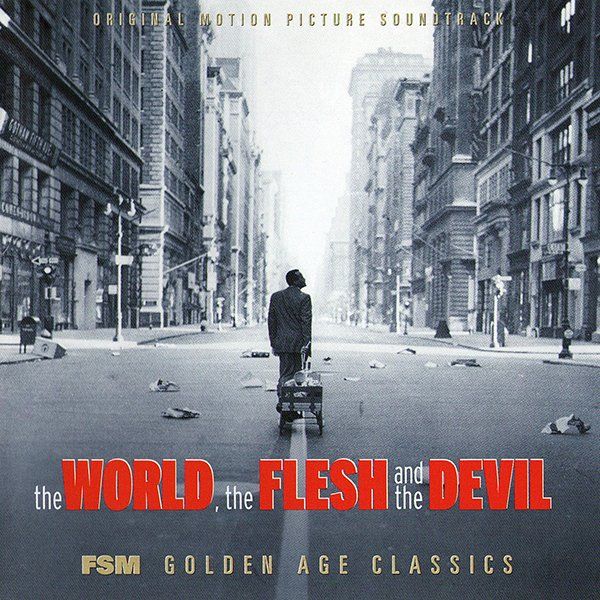The World, the Flesh and the Devil

Label: Film Score Monthly
Catalogue No: FSMCD Vol. 5 No. 15
Release Date: Nov-2002
Total Duration: 52:46
UPN: 0-63855-80144-2-4
This album marks the first release in stereo of Miklós Rózsa's complete score to the 1959 science fiction film, The World, the Flesh and the Devil, one of the composer's infrequent ventures into the genre; the other two being The Power and Time After Time. The disc marks Film Score Monthly's second recent volume of Rózsa, following The Green Berets, with a third, The Seventh Sin (1957) set to follow almost immediately. The music is of particular interest for being the score the composer completed directly prior to working on MGM's remake of Ben-Hur, generally considered Rózsa's finest music for the cinema, and indeed, one of the greatest film scores ever composed. The World, the Flesh and the Devil spans 20 tracks, including two alternate versions, and 53 minutes.
The film was an upmarket entry into the 1950's sub-genre of nuclear terror SF movies spawned by the Cold War. Absurdities abound in a premise which finds radioactive gas wiping out all but three of the world's population (the survivors are naturally all American), and mysteriously making the bodies of the other billions vanish into thin air. Nevertheless, the film aimed for quality drama with some symbolic points to be made about the human condition, in an adventure starring Harry Belafonte, Inger Stevens and Mel Ferrer. There are no bug-eyed monsters in this technically accomplished MGM drama, its seriousness attested to by the presence of the studio's most prestigious composer of the time.
One a personal note I should mention that during the early years of my love of film music I considered Miklós Rózsa to be the greatest of all film composers. That others, such as John Williams, while excellent in their way, were merely pastiching the glories of Hollywood's Golden Age and composers such as Dr Rózsa. This was in the mid to late 1970's, when I had much less knowledge of film music, and had certainly heard far less of both Rózsa's and Williams' music than I have today. My assessment of Rózsa then was based almost entirely upon such epic scores as Ben Hur, El Cid, King of Kings and Quo Vadis, together with the composer's own LP recordings on Polydor. Today my view is rather different, as Williams has proven himself the greatest of all film composers with both staggering melodic invention and a breathtaking range of styles from jazz to minimalism, encompassing everything in between. While the more Miklós Rózsa I hear the more it sounds the same.
The World, the Flesh and the Devil is a prime example of this. It is pure, classic Rózsa, instantly identifiable as the work of the composer, stamped to the core with all his hallmark traits. From the vigourous, exciting and unsettling 'Prelude' to the suspense of 'End of World / Exploring / The Dead City' to the taut malevolence and resolution of 'Manhunt in Manhattan / Stalking / Transformation / Finale' this could be no one but Rózsa. Shot through with the driving energy which electrified the composer's film noir scores a decade before - The Naked City, Brute Force - this is blistering writing, leavened by passages of more lyrical optimism. One surprise is a rare venture into jazz for the cue 'Dummies', but this is still jazz on Rózsa's terms and we soon return to his usual economical yet densely orchestrated dramatic scoring.
No doubt that now this music is finally available someone will publish a detailed analysis and comparison, but for now I shall simply record that it is both striking and a little disappointing to hear how similar much of this score is to Ben-Hur. Perhaps to suggest that rather than rise to the occasion, Rózsa simply resorted to recycling for the Roman epic is unfair. He did after all produce a tremendous amount of music for the latter picture, most of which bears no relation to The World, the Flesh and the Devil. However, many of the suspense cues here do have their echoes in the darker, more tormented passages of Ben-Hur. A Detailed comparison will be fascinating. Meanwhile, for Rózsa devotees, this may be more cut from very similar cloth, but when the pattern is as good as it is here that may be no bad thing. Given the closeness of this score in time and sound to Ben-Hur, this is a very significant première release. Highly enjoyable in its own right, The World, the Flesh and the Devil, also allows us to put one of the greatest film scores ever in context.
Given the date of recording the stereo sound is exceptional, and being a Film Score Monthly release, the packaging is first rate. An essential addition to any serious film music collection.
Originally published at MusicWeb International - Text reproduced by kind permission
Gary Dalkin is a freelance editor. Books he has worked on include John Barry: The Man With The Midas Touch (revised 2nd edition), by Geoff Leonard, Pete Walker and Gareth Bramley, and The Struggle Behind the Soundtrack: Inside the Discordant New World of Film Scoring, by Stephan Eicke. You can find out more about Gary and contact him via his website - To The Last Word



